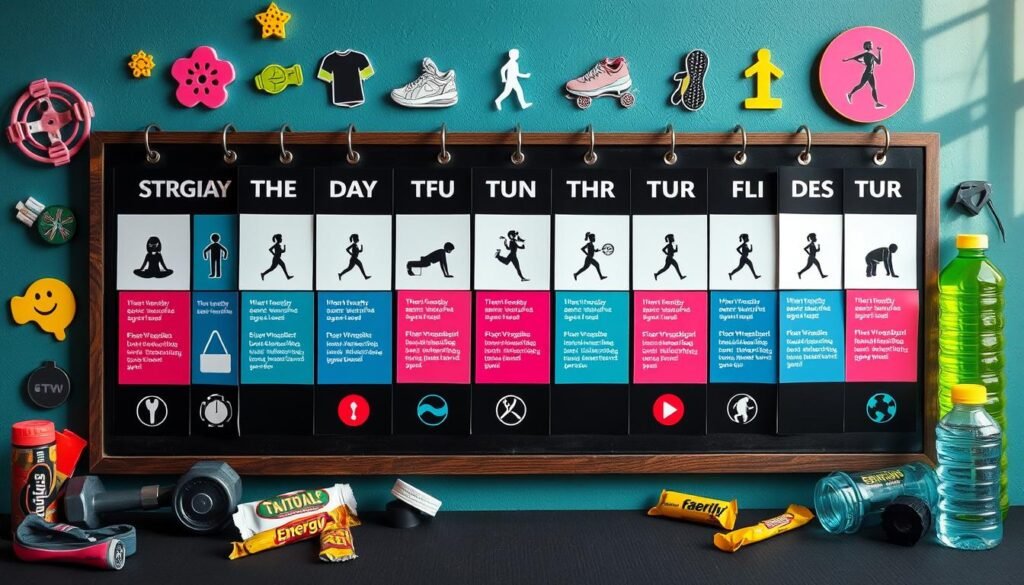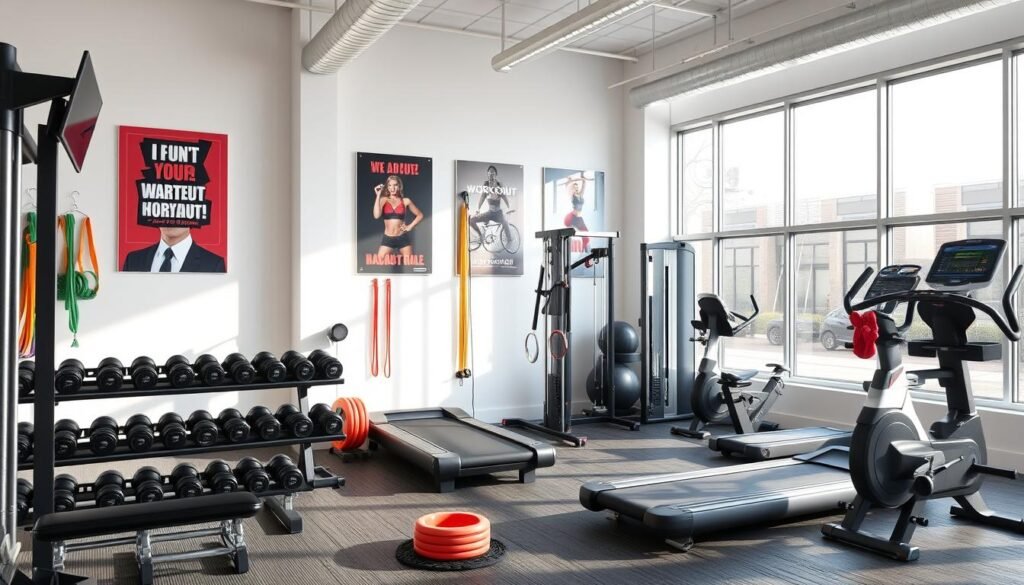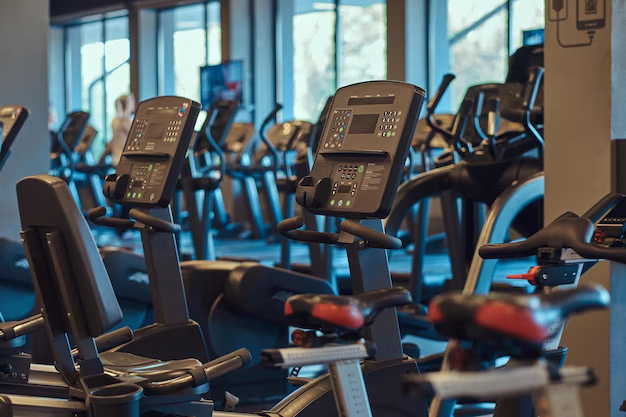Creating a good gym routine is key to reaching your fitness goals. Whether you want to build muscle, lose weight, or feel better overall, it’s important. Knowing your fitness level, setting clear goals, and planning a balanced workout are crucial steps. This guide will help you make a gym routine that fits your fitness dreams.
Key Takeaways
- Assess your current fitness level and set achievable SMART goals to guide your gym routine.
- Incorporate a combination of cardiovascular, strength, and flexibility exercises for a well-rounded fitness program.
- Optimize your workout frequency and duration for maximum efficiency and progress.
- Incorporate progressive overload and adjust your routine as you achieve your fitness milestones.
- Consistently track your progress and make necessary adjustments to your gym routine.
Also Read : Hypertension And Diet: Foods To Eat And Avoid For Healthy Blood Pressure
Understanding Your Fitness Goals and Starting Point
Before starting a new fitness journey, it’s key to know your current fitness level and set clear goals. This step helps build a strong gym routine that meets your needs and dreams.
Also Read : Diabetes Prevention: How To Lower Your Risk Of Developing Diabetes
Measuring Current Fitness Level
Begin by taking baseline measurements like your resting heart rate. This shows your heart health. The plank test checks your core strength. And, doing squats in a minute shows your lower body strength and endurance.
Setting SMART Fitness Objectives
After assessing your fitness, set SMART goals. For instance, aim to stretch or do yoga for 15 minutes, twice a week. This improves your flexibility. Clear goals help you track progress and stay motivated.
Also Read : Cancer Treatment Options: From Surgery To Immunotherapy
Determining Physical Capabilities
Understand your physical strengths and weaknesses. This helps create a safe and effective workout plan. Whether it’s running a 5K or getting stronger, knowing your limits is key to success.
| Fitness Metric | Baseline Measurement | SMART Goal |
|---|---|---|
| Resting Heart Rate | 72 bpm | Decrease resting heart rate to 65 bpm within 3 months |
| Plank Hold | 45 seconds | Increase plank hold to 1 minute within 6 weeks |
| Bodyweight Squats | 20 reps in 1 minute | Perform 25 bodyweight squats in 1 minute within 2 months |
Knowing your fitness goals and starting point helps create a gym routine for success. Remember, staying consistent and flexible are crucial for reaching your fitness goals and living a healthy life.
Also Read : The Art Of Home Cooking: Elevating Everyday Dishes
Essential Components of an Effective Gym Training Program
Creating a good gym routine means balancing strength training, cardio, and flexibility. Focus on exercises that work many muscles at once. This makes your workouts more efficient and improves your fitness in many ways.
Strength training is key, aiming for all major muscles twice a week. Choose compound exercises like squats, deadlifts, and bench presses. They work many muscles at once. Always increase the weight and reps to keep getting better.
Cardio is also crucial for health and fitness. The Department of Health and Human Services suggests 150 minutes of moderate or 75 minutes of vigorous cardio weekly. For weight loss, aim for 300 minutes of aerobic activity. Walking, cycling, swimming, and jogging are excellent choices.
Don’t forget about flexibility and balance. Include stretching and mobility exercises 2-3 times a week. This keeps your range of motion, prevents injuries, and supports movement. Balance exercises also strengthen your core and improve stability, especially for older adults.
Also Read : Urban Wildlife Conservation: Protecting Nature In Growing Cities
| Fitness Component | Recommended Frequency | Key Exercises |
|---|---|---|
| Strength Training | 2-3 times per week | Squats, Deadlifts, Bench Press, Pull-ups |
| Cardiovascular Exercise | 150-300 minutes per week | Walking, Cycling, Swimming, Jogging |
| Flexibility and Balance | 2-3 times per week | Stretching, Yoga, Balance Exercises |
By adding these key elements to your gym routine, you’ll be on the path to reaching your fitness goals. You’ll also boost your health and wellbeing.
Time Management and Workout Frequency Planning

Creating a good gym routine needs careful planning and time management. You must find the right balance for your fitness goals, schedule, and rest needs.
Optimal Training Duration
Experts say the best workout time is 45-60 minutes. This lets you do exercises that work many muscles at once. It also gives enough time for rest and recovery between sets.
Start with 30-45 minutes if you’re new to working out. As you get stronger, you can do longer sessions. For those who are more advanced, 60-90 minutes can be better.
Weekly Schedule Organization
Plan your weekly workouts to mix strength training and cardio. Beginners should aim for 2-3 gym sessions a week. Intermediate folks should aim for 3-4 gym sessions a week. Advanced athletes should do 4-5 gym sessions weekly.
This balance helps you recover well and avoid injuries. It keeps your workouts effective and safe.
Rest and Recovery Periods
Rest and recovery are key to getting the most from your workouts. Make sure to include rest days to let your muscles heal. Recovery time is also vital for your overall health and to avoid burnout.
Listen to your body and adjust your schedule as needed. This ensures your workouts are right for you and your fitness level.
“Consistency, effort, and building specific skills over time are required to change the body effectively.”
Selecting the Right Exercise Equipment and Gym Space

Starting a good workout routine begins with the right tools and space. Whether at home or a gym, picking the right gear is key to reaching your fitness goals.
For strength training, mix free weights, resistance bands, and bodyweight exercises. Free weights like dumbbells and kettlebells are versatile and target specific muscles. Resistance bands are affordable and easy to carry, fitting well into any workout.
Cardio lovers have many options, like treadmills, stationary bikes, and ellipticals. These machines burn calories, boost heart health, and adjust to your fitness level.
Setting up a home gym? Choose versatile items like dumbbells, a stability ball, and resistance bands. They save space and are great for many exercises. Make sure your gym area is safe, comfy, and fits your workout plans.
“Creating a home gym can be a game-changer for individuals who prioritize their fitness. It offers the convenience of working out on your own schedule, without the added cost and commute of a commercial gym.”
Choosing the right equipment and gym space depends on your fitness goals and what you have available. Quality, versatile gear and a well-set-up area make for a fun and effective workout routine.
| Equipment | Benefits | Considerations |
|---|---|---|
| Free Weights |
|
|
| Resistance Bands |
|
|
| Cardio Equipment |
|
|
Building a Balanced Workout Routine
Making a good gym routine means mixing different types of exercises. This way, you work on your heart health, build strength, and get more flexible. Let’s explore what makes a complete workout plan.
Cardiovascular Training Elements
Cardio is key for a healthy heart, better endurance, and calorie burn. The Physical Activity Guidelines say adults should do at least 150 minutes of moderate cardio or 75 minutes of vigorous cardio weekly. Good cardio options include walking, jogging, cycling, or swimming.
Strength Training Fundamentals
Adding strength exercises to your routine is vital for muscle growth, stronger bones, and better fitness. The guidelines suggest doing two or more strength training sessions weekly, with at least 48 hours of rest in between. Choose compound movements like squats, deadlifts, and push-ups to work out many muscles at once.
Flexibility and Mobility Work
Keeping your body flexible and mobile helps prevent injuries, improves movement, and boosts overall health. Add stretching, yoga, or Pilates to your routine to boost flexibility and mobility. This is especially important for older adults to avoid falls and injuries.
By mixing cardio training, strength exercises, and flexibility and mobility work in your routine, you’ll reach your fitness goals and stay healthy and active.
Progressive Overload and Training Intensity

To reach your fitness goals, it’s not enough to just go to the gym. You need to use the progressive overload principle. This means slowly adding more weight, doing more reps, or training more often.
Studies prove that regular, gradual increases in workout intensity are key. Occasional weightlifting won’t give you the same results as consistent, intense training. Start with light weights to avoid getting too tired too quickly. As you get stronger, aim to increase the weight or reps by 10% each week to stay safe and avoid injuries.
It’s also important to mix up your training intensity. Try high-intensity interval training (HIIT) for short, intense workouts followed by rest. This method boosts your heart health, muscle growth, and strength.
Adjusting your workout intensity should match your fitness level and goals. Talk to a certified personal trainer to make a plan that suits you. By gradually increasing the challenge and mixing up your workouts, you’ll reach your full potential for muscle growth and strength gains.
“The key to continuous progress in the gym is to constantly challenge your body in new ways. Gradual, methodical increases in training intensity and volume are the path to sustainable muscle growth and strength gains.”
- Aim for no more than 10% weekly increases in weight, duration, or repetitions to avoid injury and plateaus.
- Incorporate HIIT workouts to boost cardiovascular fitness, muscle growth, and strength.
- Consult a certified personal trainer to create a personalized progressive overload plan.
- Focus on proper form and listen to your body to ensure safe and effective workout progression.
Tracking Progress and Making Adjustments
![]()
It’s important to keep an eye on your fitness journey. By tracking your progress, you can see how far you’ve come. This helps you make changes to keep moving forward.
Performance Metrics to Monitor
Watch your progress by tracking things like weight lifted and running distance. Testing your strength regularly can also show how you’re doing. Feeling good during and after workouts is another sign of success.
When to Modify Your Routine
Check your fitness level often. If you’re not getting better or your goals have changed, it’s time to adjust. Try new exercises or change how often you work out to keep improving.
Success Indicators
Look for signs of getting better, like stronger muscles or more endurance. These signs can motivate you to keep going. Celebrating your achievements helps too.
Check your fitness plan every 6-8 weeks. This ensures you’re still moving towards your goals. By tracking your progress and making changes, you’ll reach your fitness dreams.
| Progress Tracking Metrics | Routine Adjustment Triggers | Success Measurement Factors |
|---|---|---|
|
|
|
“Tracking your progress is the key to unlocking continuous improvement in your fitness journey. Embrace the data, celebrate your wins, and make timely adjustments to propel yourself forward.”
Also Read : How Can Cardio Exercises Help With Weight Loss?
Conclusion
Creating a good gym routine is key to a rewarding fitness journey. It helps you reach your health and wellness goals. Start by knowing your fitness level, setting clear goals, and making a balanced workout plan.
Staying consistent, tracking your progress, and making changes as needed keeps you motivated. Fitness is a journey, not a quick fix. Enjoy the journey, celebrate small wins, and have a supportive network for success.
Whether you want to get stronger, last longer, or live a more active life, this guide has you covered. Take control of your fitness journey. Be dedicated, trust the process, and see how it transforms you into a healthier, happier person.





